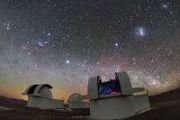
Copernical Team
Loathed by scientists, loved by nature: sulfur and the origin of life
 Many artists have tried to depict what Earth might have looked like billions of years ago, before life made its appearance. Many scenes trade snow-covered mountains for lava-gushing volcanoes and blue skies for lightning bolts pummeling what's below from a hazy sky.
But what did early Earth actually look like? This question has been the subject of intense scientific research for decades.
Many artists have tried to depict what Earth might have looked like billions of years ago, before life made its appearance. Many scenes trade snow-covered mountains for lava-gushing volcanoes and blue skies for lightning bolts pummeling what's below from a hazy sky.
But what did early Earth actually look like? This question has been the subject of intense scientific research for decades. Aerospacelab Achieves Milestone with Quadruple Satellite Launch
 Aerospacelab has successfully doubled its number of satellites in orbit by launching four new satellites. The launch took place at Vandenberg Space Force Station in California, USA, at 2:05 pm PT on March 4th aboard a Falcon 9 rocket as part of SpaceX's Transporter-10 mission.
Shortly after takeoff from Space Launch Complex 4E (SLC-4E), the satellites were confirmed to be in good condition
Aerospacelab has successfully doubled its number of satellites in orbit by launching four new satellites. The launch took place at Vandenberg Space Force Station in California, USA, at 2:05 pm PT on March 4th aboard a Falcon 9 rocket as part of SpaceX's Transporter-10 mission.
Shortly after takeoff from Space Launch Complex 4E (SLC-4E), the satellites were confirmed to be in good condition Webb finds ethanol, other icy ingredients for making planets
 What do margaritas, vinegar, and ant stings have in common? They contain chemical ingredients that NASA's James Webb Space Telescope has identified surrounding two young protostars known as IRAS 2A and IRAS 23385. Although planets are not yet forming around those stars, these and other molecules detected there by Webb represent key ingredients for making potentially habitable worlds.
An in
What do margaritas, vinegar, and ant stings have in common? They contain chemical ingredients that NASA's James Webb Space Telescope has identified surrounding two young protostars known as IRAS 2A and IRAS 23385. Although planets are not yet forming around those stars, these and other molecules detected there by Webb represent key ingredients for making potentially habitable worlds.
An in Algorithms help chart the origins of heavy elements
 The origin of heavy elements in our universe is theorized to be the result of neutron star collisions, which produce conditions hot and dense enough for free neutrons to merge with atomic nuclei and form new elements in a split-second window of time. Testing this theory and answering other astrophysical questions requires predictions for a vast range of masses of atomic nuclei. Los Alamos Nation
The origin of heavy elements in our universe is theorized to be the result of neutron star collisions, which produce conditions hot and dense enough for free neutrons to merge with atomic nuclei and form new elements in a split-second window of time. Testing this theory and answering other astrophysical questions requires predictions for a vast range of masses of atomic nuclei. Los Alamos Nation Chinese scientists push for Solar Polar Orbiter
 Yang Mengfei, a prominent spacecraft scientist and advisor, has urged for state backing in developing a satellite designed for solar observations from a unique solar polar orbit. This initiative aims to deepen our understanding of solar phenomena that significantly influence earthly technologies and natural occurrences.
Yang, a senior researcher at the China Academy of Space Technology and
Yang Mengfei, a prominent spacecraft scientist and advisor, has urged for state backing in developing a satellite designed for solar observations from a unique solar polar orbit. This initiative aims to deepen our understanding of solar phenomena that significantly influence earthly technologies and natural occurrences.
Yang, a senior researcher at the China Academy of Space Technology and U.S. Space Force Invests $15M in Defense Unicorns for Strategic Space Software Enhancements
 In a significant boost to national security and space capabilities, Defense Unicorns, a pioneering open-source software and Artificial Intelligence (AI) provider, has secured a $15 million funding boost from the U.S. Space Force. This Strategic Funding Increase (STRATFI), in collaboration with the Program Executive Office Assured Access to Space (AATS), aims to enhance and expand secure software
In a significant boost to national security and space capabilities, Defense Unicorns, a pioneering open-source software and Artificial Intelligence (AI) provider, has secured a $15 million funding boost from the U.S. Space Force. This Strategic Funding Increase (STRATFI), in collaboration with the Program Executive Office Assured Access to Space (AATS), aims to enhance and expand secure software UTS and Space Machines Company Forge Pioneering Partnership for Space Sustainability
 In an ambitious move marking a new chapter for Australia's space industry, the University of Technology Sydney (UTS) has joined forces with Space Machines Company (SMC), aiming to enhance space sustainability. This collaboration is set against the backdrop of Australia's goal to expand its space economy from AU$4 billion to AU$12 billion by 2030, alongside creating 20,000 jobs.
During a st
In an ambitious move marking a new chapter for Australia's space industry, the University of Technology Sydney (UTS) has joined forces with Space Machines Company (SMC), aiming to enhance space sustainability. This collaboration is set against the backdrop of Australia's goal to expand its space economy from AU$4 billion to AU$12 billion by 2030, alongside creating 20,000 jobs.
During a st BlackSky Secures $24M AFRL Contract to Advance AI-driven Global Target Tracking Solutions
 BlackSky Technology Inc. (NYSE: BKSY) has been awarded a significant $24 million contract by the Air Force Research Laboratory (AFRL) to enhance moving target engagement capabilities through development and demonstration. The contract showcases BlackSky's innovative approach to integrating artificial intelligence (AI) with satellite technology for improved detection, tracking, and identification
BlackSky Technology Inc. (NYSE: BKSY) has been awarded a significant $24 million contract by the Air Force Research Laboratory (AFRL) to enhance moving target engagement capabilities through development and demonstration. The contract showcases BlackSky's innovative approach to integrating artificial intelligence (AI) with satellite technology for improved detection, tracking, and identification Revolutionary Ultrablack Coating Unveiled for Superior Telescope Performance
 In the quest for clearer astronomical images and superior optical performance, the key might just lie in achieving the deepest possible black. The pursuit of such a goal has led researchers to develop an innovative ultrablack coating, set to significantly improve next-generation telescopes and optical devices. This breakthrough, published in the Journal of Vacuum Science and Technology A by AIP
In the quest for clearer astronomical images and superior optical performance, the key might just lie in achieving the deepest possible black. The pursuit of such a goal has led researchers to develop an innovative ultrablack coating, set to significantly improve next-generation telescopes and optical devices. This breakthrough, published in the Journal of Vacuum Science and Technology A by AIP Space Force Seeks New Partners for $986 Million OSP-4 Launch Services Contract
 The U.S. Space Force, through its Small Launch and Targets Division located at Kirtland Air Force Base in Albuquerque, New Mexico, has officially issued a call for additional service providers to join the Orbital Services Program (OSP)-4. This move, spearheaded by the Space Systems Command's (SSC) Assured Access to Space (AATS) initiative, aims to broaden the roster of launch providers eligible
The U.S. Space Force, through its Small Launch and Targets Division located at Kirtland Air Force Base in Albuquerque, New Mexico, has officially issued a call for additional service providers to join the Orbital Services Program (OSP)-4. This move, spearheaded by the Space Systems Command's (SSC) Assured Access to Space (AATS) initiative, aims to broaden the roster of launch providers eligible 





























